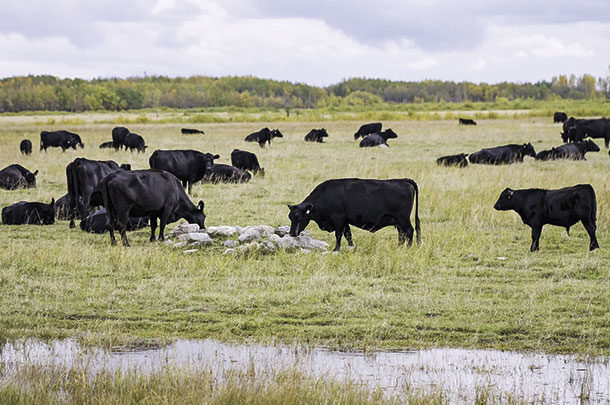Mycotoxins are rarely the first factor considered when evaluating potential reasons for poor breed-back, weak calves, rough hair coats, or overall poor growth or reproductive performance in cattle grazing pastures throughout the U.S.
According to reported U.S. mycotoxin surveys, there has been a variety of mycotoxins detected in grazing forages in all regions of the U.S. in recent years. Therefore, the consideration of mycotoxins as contributing factors in cases of poor health and performance of grazing livestock is justified.
Mycotoxins are secondary fungal metabolites found in cereal grains, harvested forages and pasture grasses, and pose a significant threat to animal health and productivity. Crops that have experienced environmental challenges, such as heat and drought stress, excessive moisture or physical damage (e.g., hail, insects, wildlife) during certain phases of growth present with the greatest risk of colonization by molds that may develop toxins.
Identifying the challenge
The severity of negative effects from mycotoxins in cattle is influenced by a number of factors, including the type of mycotoxin, age of the animal, health status, and the duration and degree of exposure. Animals exposed to a high level of mycotoxins or long duration of exposure may show clinical signs of mycotoxicosis, which range widely from reduced intake, poor growth, immunosuppression, impaired reproduction or even death.
Additionally, low to moderate levels of toxins may cause subclinical signs that are not readily observable but can still cause poor growth and reproductive performance, leading to economic losses. Furthermore, the co-occurrence of more than one mycotoxin may result in animals presenting with a variety of signs that are more severe than if a single mycotoxin was present.
To effectively reduce mycotoxin risk, it is important to be aware of the forage type and environmental conditions that may be favorable to the growth of fungal species that could produce a mycotoxin which potentially threatens the health of your herd. Some major mycotoxin-producing fungi that have been identified and are prevalent in forages grazed by cattle include endophytic species of fungi such as epichloë and neotyphodium as well as multiple fusarium species, which have historically been associated with cereal contamination.
Fusarium molds are known for producing several different mycotoxins including zearalenone (ZEN), fumonisins (FUM), type A trichothecenes (such as T-2 toxin and HT-2 toxin) and type B trichothecenes which includes deoxynivalenol (DON aka “vomitoxin”), nivalenol (NIV) and fusarenon X (FusX). Fusarium molds are believed to be produced after stress conditions followed by wet weather during flowering. Each fusarium mycotoxin presents their own negative effects on cattle growth and reproductive performance and, unfortunately, these toxins have been identified in a broad range of native grass species, legumes and perennial grasses.

The severity of negative effects from mycotoxins in cattle is influenced by a number of factors, including the type of mycotoxin, age of the animal, health status, and the duration and degree of exposure. Animals exposed to a high level of mycotoxins or long duration of exposure may show clinical signs of mycotoxicosis, which range widely from reduced intake, poor growth, immunosuppression, impaired reproduction or even death. Photo courtesy of Biomin.
Although each of the fusarium mycotoxins may display different outward symptoms, type A and B trichothecenes are known to reduce gut integrity by inhibiting protein and nucleic acid synthesis, resulting in reduced nutrient absorption and immune function. Similar to DON, FUM contribute to the disruption of the intestinal barrier and act synergistically in the presence of DON and other mycotoxins, imposing greater negative effects when found in combination than when occurring alone.
Zearalenone is frequently found in the presence of DON and other type B trichothecenes and primarily has an estrogenic effect on animals, which can significantly impair heat cycles, embryo survival and cause abortions in cows as well as poor testicular development, sperm production and semen quality in bulls.
Ergot alkaloids are another prevalent mycotoxin group affecting grazing beef cattle in many regions of the U.S. Ergots are produced by fungi that infect susceptible small grain and grass species including triticale, rye, wheat, barley, oats, as well as many wild cultivated grasses such as annual bluegrass, cheatgrass, green foxtail, wild barley and wild oat, brome, fescue, timothy and wheatgrasses. Favorable conditions for ergots have been associated with a cool wet spring followed by a hot early summer, as well as grasses that have excessive moisture content or harvested late. Negative effects from ergot alkaloids, also known as ergotism, includes severe vasoconstriction of small arteries leading to gangrene of the limbs and ears, rough hair coat, and poor growth and reproductive performance.
Prevalence of mycotoxins in grasses
An ongoing mycotoxin survey beginning in March 2016 has identified the potential for high levels of contamination in several grasses throughout the U.S. To date, over 400 pasture samples have been screened for up to 17 mycotoxin metabolites at one of two analytical laboratories (Romer Labs, Union, Missouri; ActLabs, Ancaster, Ontario).
The majority (85%) of samples were bermudagrass collected in the Southeast. In bermudagrass samples, over two-thirds (68%) tested positive for some level of ZEN (average 1,718 parts per billion [ppb] on a dry matter basis), and around 20% tested positive for type A trichothecenes (average 1,226 ppb). In addition, forage samples from 2019 showed 56% of samples tested had one mycotoxin detected, and 18% of the samples had co-occurrence of more than one mycotoxin.
According to the survey, the observed contamination varied over time, with the highest mycotoxin levels detected during the winter months and early spring. High variability has also been seen between pastures, with some pastures not having any mycotoxins detected and others with very high levels occurring. Reproductive challenges including low conception rates and abortions, lower body condition score in dams, reduced calf crop and decreased calf-weaning weights have been reported in cattle grazing pastures with contamination.
Mycotoxins have also been widely identified in harvested hays including meadow or prairie hay, brome and others. More recently, there have been reports of a number of producers experiencing significant numbers of open cows in early spring timeframe, indicating a potential mycotoxin challenge during winter feeding of contaminated harvested hays. Regardless of the source of mycotoxin, it is important to be vigilant of a potential mycotoxin challenge by paying close attention to the growing conditions and submitting feed samples to be evaluated for mycotoxins.
Mitigating the mycotoxin risk
Mitigating mycotoxins in grazing environments can be a challenge to identify and quantify the risk of the challenge in order to reduce mycotoxin exposure and prevent negative effects. Since cattle are selective grazers, and mycotoxins are not evenly distributed throughout pastures, crops or feedstuffs, obtaining representative samples for testing may be difficult but does still serve a benefit to better understanding the feed environment.
A highly contaminated sample does not mean the entire pasture or feedstuff is bad, and a “clean” sample does not guarantee that all of the feed is mycotoxin-free. Although limitations exist, mycotoxin analysis of feeds can provide useful information to aid in making decisions for which pastures to graze and when or to help determine the inclusion level of the contaminated feedstuff in the diet.
There are a number of clay and yeast products on the market that can bind (adsorb) mycotoxins, but it is important to pair the correct product with the correct mycotoxin. For instance, the chemical and physical properties of the mycotoxin play a big role in determining whether the toxin can effectively be adsorbed by a binder.
In addition, binder products vary in their composition and chemical structure, leading to variability in their effectiveness at adsorbing mycotoxins. Aflatoxins and ergot alkaloids are often sufficiently controlled by clay-type binders. However, zearalenone and trichothecenes are poorly adsorbed and require other methods, such as detoxification through enzymatic activity that alters their chemical structure, thus preventing biological activity of the toxin in the animal.
Additional components some products may include are plant and algae extracts that have been identified to repair and reduce damage to the liver and provide support to the immune system. Combination products which provide activity through binding, enzymatic degradation and protective plant and algal extracts can provide broad-spectrum mycotoxin control to combat a variety of types and levels of mycotoxins frequently identified in pasture grasses and feeds.










